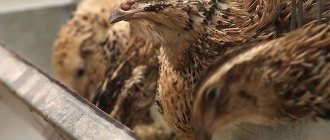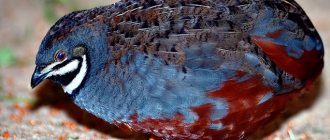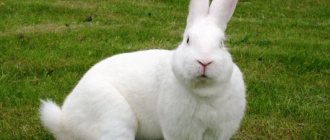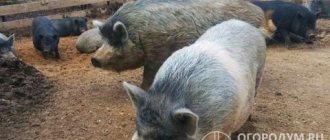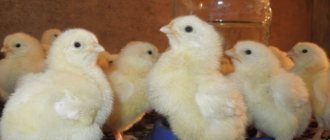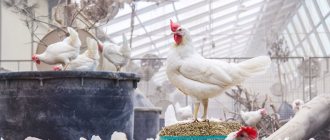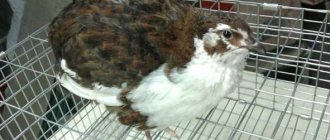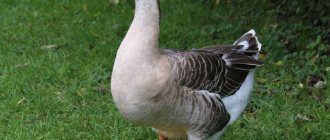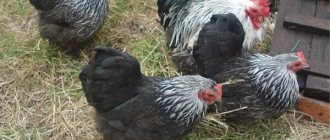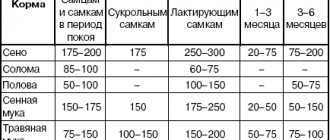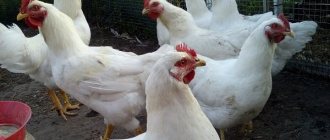Home » Articles about quail » Texas white quail
Texas white quail, another name for which is “white pharaoh”, are broiler birds with high meat productivity. They are the largest and heaviest representatives of their species. Texas quails are not particularly difficult to keep, so they are suitable for growing both in industrial and home conditions.
A little about the breed
American breeders worked on the breed. The ancestor was the Japanese quail, and only large specimens were selected for selection. The breed got its white color by crossing a Japanese with a white English quail.
In appearance, the Texan is similar to the English representative. The breed is one of the promising ones, since the birds are unpretentious in their care and have low demands on their diet. Unlike Pharaohs, they quickly gain weight and have tender meat.
Today, Texas broiler is grown everywhere not only in America, but also in central Russia.
Characteristic
Texas quails first appeared in America. Their ancestors were the best representatives of the Japanese and English quail breeds. The birds inherited their white color from their English relatives, and they inherited good egg production from the Japanese breed. Other names for large Texans include:
- snow (Texas) pharaoh;
- albino broiler;
- white (Texas) giant.
The names indirectly indicate the surprisingly large weight of the bird or the snow-white plumage that is different from other quails, which is immediately noticeable in the photo of the Texas quail breed.
Appearance
A representative of this breed has white plumage; small dark gray spots on the head are allowed. At the same time, under the white plumage the skin has a pinkish color, and in places of spots it is gray. Therefore, when selecting young birds, chicks with a minimum number of spots are selected in order to improve the appearance of the carcass.
The bird's plumage is lush. The back and convex chest are well developed. A small head and short neck are discordant with a large, dense build. The eyes are round and black, the beak is beige, sometimes with a dark tip. The light pink legs are muscular.
Description
According to the characteristics, the Texas breed of quail is distinguished from other representatives of the genus by a number of parameters:
- Color. Quails have white plumage and resemble small chickens. Several spots are allowed (up to 3).
- Body shape. Like most meat breeds, Texas stockies are distinguished by a wide breast and muscular legs.
- Beak color. Laying hens have a neat pink beak, which indicates that they belong to the breed and have good physical parameters.
Texas quails are much larger than other quail breeds, approximately 1.5 times larger, but at the same time they are very peaceful and calm. According to the description of the breed, the Texas quail has such a calm character that it can be kept in any home environment. The neighbors won’t even notice that someone has a small poultry farm in their apartment.
Advantages and disadvantages of the breed
The breed has both significant advantages and disadvantages.
The positive aspects include:
- The birds gain weight quickly and have a high carcass yield at slaughter (approximately 260 g). Males weigh 360 g, females - 450 g. Individuals are often fattened to a maximum weight of 550 g.
- The carcass has an attractive appearance and the meat is tasty.
- The feather is easy to pluck.
- An unpretentious bird to keep, easy to care for.
- They are not shy and have a calm disposition.
- Females have virtually no problems with the oviduct.
- They begin to lay eggs early - from the age of two months.
However, the breed has no less disadvantages:
- Low or average egg production, but there should be no questions here, since the breed is of the meat type. Quail eggs are laid large, they can weigh up to 20 g. On average, the weight of one egg is 12-14 g. Often there are two yolks in one egg. However, such eggs are only suitable for food; eggs weighing 10-11 g are selected for incubation.
- Due to their phlegmatic nature, males show little activity towards females; due to such a cool attitude towards the opposite half, problems arise with breeding, since egg fertilization is low. Therefore, there should be 1 cockerel for every 2 females.
- The hatchability of chicks is also not encouraging and averages 60%.
- Chicks are born weak, intolerant and require careful attention. Survival rate is 70-80%.
- High feed consumption.
- It is impossible to distinguish a female from a male right away; you will have to wait until they begin to lay eggs or learn to identify them by other signs.
Texas quail is sold everywhere!
It just so happens that there are now many fans where you can easily buy an adult laying Texas broiler quail, but few people think that quail and quail are different and the breed in the Krasnodar region has long been no longer pure
Basically, you will be offered a cross between a quail or a bird that did not pass the selection and was culled for a symbolic price of 80-100 rubles. If this is not so important for you, then you can neglect this, since the young animals are not from a pure breed and are the same. the egg is small and the carcass is small, so why then ask to buy such a “mixed breed”? We also encountered this, for starters, a bird can be identified by its exterior (appearance):. - the bird's plumage is white
- The bird's plumage is white.
- on the head there is one spot of black (not red! color) measuring no more than 7 * 7 mm, it is also possible that such a spot is absent.
— on the body it is extremely rare (on 5-10 quails out of 100 pieces) it is possible to have several black (not red!) feathers in the back area.
Body weight by 50 days is at least 350-420 grams.
It is extremely difficult to get such a bird and the price of a laying hen is far from 100 or 130 rubles. These listed characteristics in quail are breeding birds. Such birds are obtained by the method of long and painstaking selection, the “BEST OF THE BEST” method, which has proven itself, you can work with it for up to 5 years without adding new blood to the flock, obtaining large and healthy birds in subsequent generations.
If you allow all birds to breed without selection, then in the third generation you will receive small quails that require blood renewal.
How to distinguish a female from a male?
People with a good ear for music who have already heard male and female “trills” of quails can distinguish them by their voices. In males it is shrill and sharp, in quails it is more melodic and melodious, reminiscent of a quiet purr. Unable to figure out the sounds made by birds? Then there is a more practical way.
Chicks go through puberty at five weeks from birth. At this age, it is already possible to distinguish the sex of individuals by the shape of the genital organs. To do this, take her and turn her tummy towards you. Near the cloaca the feathers are spread apart. In females, this zone has the shape of an elongated slit; in males, the cloaca is rounded, and if you lightly press on the sides, a white-colored liquid appears.
Maintenance and care
Texans are housed in any room or structure. The main thing is that there are no drafts, it is warm, light and dry.
Lighting
It is better to make windows on the south or east side. Quails do not like direct sunlight; they are curtained with light cloth or netting or placed in cages away from windows. They also feel good under artificial lighting; 2 lamps of 40 W each are enough. Daylight hours are maintained up to 16-17 hours a day.
Ventilation
Be sure to install ventilation so that the air circulates in the barn and does not stagnate. Birds will also enjoy a small courtyard for walking. It is fenced with a fine mesh to prevent those who like to feast on them from entering the territory of the quails - these are cats, rats and other living creatures, and they make a canopy that protects the livestock from direct sunlight. The exercise pen should be at least 10-15 square meters. m. When kept in this way, quails do not experience stress and anxiety, and feel as if they are in their own element.
Cells
If there is little space, then cage keeping is practiced. The cages are installed in rows in several tiers.
When calculating, it is necessary to take into account that one bird needs 20-30 cm of personal space (ideally 50 cm), the height of the structure should be 40 cm, and not 20 cm as for other smaller breeds. The optimal cell size is 35x45 cm, so that the quail can easily stick its head through.
Each cage is equipped on the outside with a drinker and a feeder, and egg collectors are made, since laying hens can easily crush eggs on the floor. This design makes caring for birds much easier.
To make it easier to clean out droppings, pull-out plastic and wooden pallets are made underneath.
Quails fattened for slaughter are divided by gender - into cockerels and laying hens, and kept separately from each other.
Read about how to make a quail cage with your own hands here.
Temperature
Texas broilers react acutely to sudden changes in temperature. A comfortable temperature for them is +18-22 °C. If the thermometer drops lower, the birds begin to freeze and huddle together to keep warm. Such crowding sometimes leads to their injury.
At temperatures above 22 °C, birds become completely lazy and passive. The signal that quails are hot is their behavior. They breathe frequently and keep their beak open.
Air humidity
It is also necessary to control air humidity. Its optimal indicators are 60-70%. As humidity increases, birds gain less weight, lay eggs worse, and often get sick, resulting in an increased mortality rate.
Light mode
Immediately after hatching and transplanting into the brooder, 24-hour lighting should be provided.
To prevent pecking and increased nervousness, brightness for adult Texas quail is limited. Twilight will be enough, and light is needed only for the feeding and drinking area. Direct sunlight is contraindicated.
It is not recommended to use bright lamps to heat the brooder, because the chicks can get burned on the hot surface. The best option is ceramic lamps.
What to feed?
The Texas Giants are famous for their excellent appetites. To gain weight quickly, your diet must be balanced. One quail eats up to 40-50 g of feed per day, that is, for a population of 100 birds you will need up to 4-5 kg of feed per day. Industrial high-quality feed is purchased for them.
Unlike chickens, quails immediately begin to eat food for adult birds, only in a more crushed form. But to accelerate the rate of weight gain, they are fed according to the following scheme:
- First, hatched quails are given food rich in proteins:
- chopped boiled eggs;
- cottage cheese rubbed through a fine sieve;
- fermented milk products - yogurt, kefir.
- Next, greens, finely ground crackers, and food for the chicks are introduced.
- For older chicks, feed is added, as well as foods rich in calcium - chalk, shells, crushed shells and bone meal.
- The menu of females that have begun to lay eggs must include crushed raw sea fish and salt.
Birds should always have fresh water at room temperature in their drinking bowls from birth so that they can drink freely at any time.
Nutritional Features
The diet of meat quails must be formulated in such a way that it contributes to intensive weight gain of the bird. For this purpose, mineral supplements, vitamins and herbs are added to the feed. If this condition is not met, the quail will often get sick and gain weight poorly. When fattening, proteins, fats and corn should be included in the diet. The best example of a menu is a mixture consisting of 20% corn (boiled) + peas and 80% animal feed. However, it is necessary to gradually change the food schedule by introducing new foods into the diet. Sudden changes can cause illness in the bird, and in some cases death. In the first days, 40% of the food familiar to birds is replaced with a new one, on days 3-4 this is already 60%, etc. until the new diet is fully introduced. This method allows the quail’s body to adapt to changes and accept them normally. Also read about raising and keeping Victoria turkeys in this material.
What is important to consider when fattening
When starting to fatten meat quails for slaughter, the following conditions must be taken into account:
- Males and culled females are used for fattening when they reach one month of age. You can also take adults after 8 months if egg production decreases.
- After reaching the age of one month, females and males are kept separately.
- Birds require a special lighting regime. For the first 2.5-3 weeks, birds live with a lack of light (darkened cage), then an alternating regime of light and darkness is organized (hour of light - hour of darkness). Lighting should not be direct, it should be diffused.
- The fattening period lasts approximately 21-28 days. At this time, birds must be given the opportunity to move freely at least 3 times a day.
This link will tell you about the characteristics of the Wyandotte chicken breed.
Breeding Texans
Laying hens of this breed are completely devoid of the brooding instinct; even when kept in an enclosure, no more than 3% of females become hens. Therefore, breeding Texans is only possible with the help of an incubator.
When incubating, there are several nuances that should be taken into account:
- For incubation, it is better to take eggs from young females who are not yet 10 months old. In more mature individuals, the number of fertilized eggs decreases several times.
- Eggs are collected within 7 days and stored at +18-22 °C.
- Chicks hatch on days 16-18, but usually a mass “birth” occurs on the 17th day.
- It is not necessary to turn the eggs during incubation. This does not in any way affect the successful hatching and health of the chicks in the future (according to the observations of specialists).
- Newborn quails are left in the incubator for several hours so that they dry completely, and only then are they moved to a special room - a brooder, where the optimal temperature is maintained for them (32-34 ° C). Otherwise, the feathers will dry out quickly and become covered with a hard crust.
For two-week-old quails, the ambient temperature begins to gradually decrease, and by the end of the third week it is brought to +26 °C. Four-week-old young animals are transferred to cages or a common place where the temperature is maintained within 22-24 °C.
Diseases and prevention
Unlike the egg and meat-egg breeds, Texans have a weaker immune system. Therefore, for prevention, starting from three days of age, they are given vitamin preparations. The birds are also fed with high-quality, balanced feed, calcium-containing foods and proteins. Be sure to monitor the quality of drinking water. It should not be musty, cold or heated. The sick bird is immediately separated from its healthy counterparts separately.
The most common diseases are associated with improper keeping of quails and lack of nutrients in their diet.
Birds are susceptible to:
- vitamin deficiency;
- cannibalism;
- baldness - loss of plumage.
Find more information about quail diseases and their treatment here.
How to distinguish a sick bird from a healthy one?
To understand which bird is sick, you need to observe the behavior of the birds:
- A sick bird becomes lethargic and usually hides in a corner.
- Shows no interest in what is happening around her.
- Refuses to eat, and sometimes to drink.
- Her feathers are ruffled, her eyes are half-closed.
- She throws her head back and stretches her neck.
- Pulls out feathers and pecks eggs.
Sick birds must be identified promptly and the cause of their poor health must be sought. Often, having eliminated the negative factors of maintenance or nutrition, the bird recovers without any consequences.
How much does it cost and where to buy a white Texas broiler?
If you are going to purchase this breed of bird, then choose a trusted seller so as not to be disappointed in the purchase in the future. The white Texas broiler is similar in appearance to the English quail, which is much smaller in size, as it is an egg breed. When purchasing, pay attention to the plumage; the fewer dark spots, the better - the carcass will have a more attractive appearance.
On average, the price of laying hens varies from 100 to 200 rubles, depending on age; the younger the individual, the cheaper it costs. So, the price for a daily quail is 40-60 rubles. You can also find hatching eggs on sale for 15 rubles per piece, but no one can guarantee that it is fertilized and that a Texan will definitely emerge from it.
Poultry is purchased from farms that breed them or from private owners.
The White Texas Broiler and the Pharaoh are two meat breeds that are available in the poultry market. Everyone decides for themselves which breed to choose. The main characteristics are presented in the table below.
| Breed/traits | Texas White Broiler | Pharaoh |
| Female weight (average), g | 450 | 300 |
| Cockerel weight (average), g | 360 | 250 |
| Egg production (pieces/year) | 200 | 220 |
| Egg weight, g | 15 | 18 |
This breed of quail is well suited for breeding and selling meat. The requirements are not too high, unlike many other breeds. The products are high quality, the business pays off quickly. But you'll have to tinker a little with breeding
0
0
Copy link
Productivity options
The economic efficiency of raising Texas quails is high, since the costs of their maintenance differ slightly from the costs of raising quails of other breeds, and the yield of meat and egg products is much higher. So, the productivity indicators are as follows:
- The weight of a laying hen is 400-450 g, the weight of a cockerel is 300-360 g. After slaughter and processing, a carcass remains weighing about 250 g.
- Egg productivity - 260 pcs. in year. The eggs are large, each weighing 13-16 g. There is evidence that quails laid eggs up to 25 g, but this is very rare.
One of the characteristics of Texas plants is early ripening. Laying hens become sexually mature at the age of 45 days and immediately begin laying eggs. Chickens show the greatest productivity at the age of 5-6 months. The older the chicken, the lower the egg production. At 8-9 months, it is advisable to replace laying hens with younger ones.
Texas meats are valued in the meat market not only for their excellent taste, but also for their excellent presentation. Quail carcasses of this breed stand out from the rest with their white-yellowish skin and light meat.
Quails raised for meat are usually slaughtered 4-5 months after birth. By this time, the chickens are gaining maximum weight.
